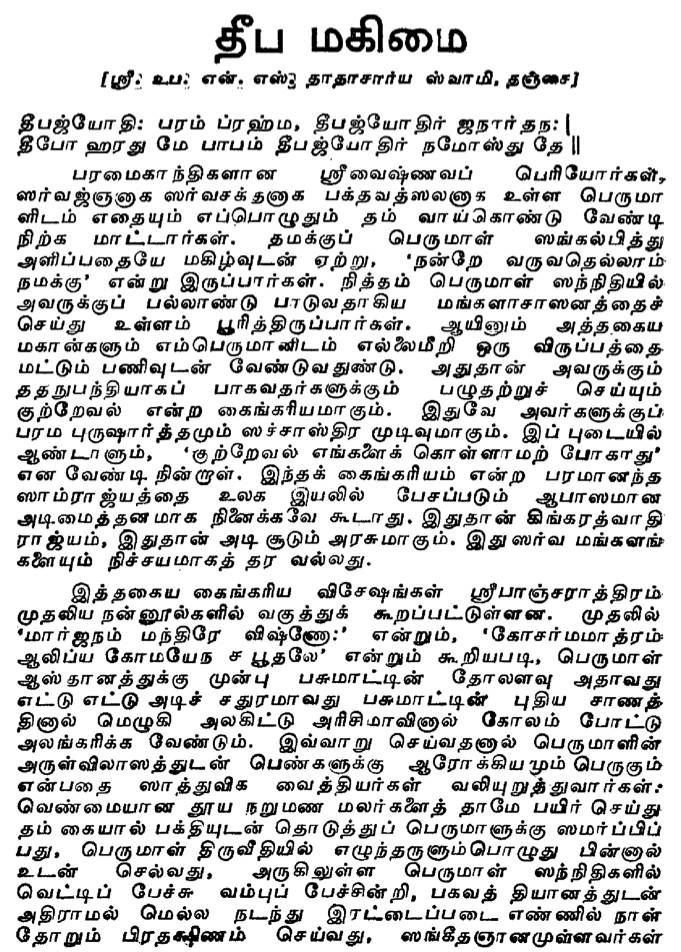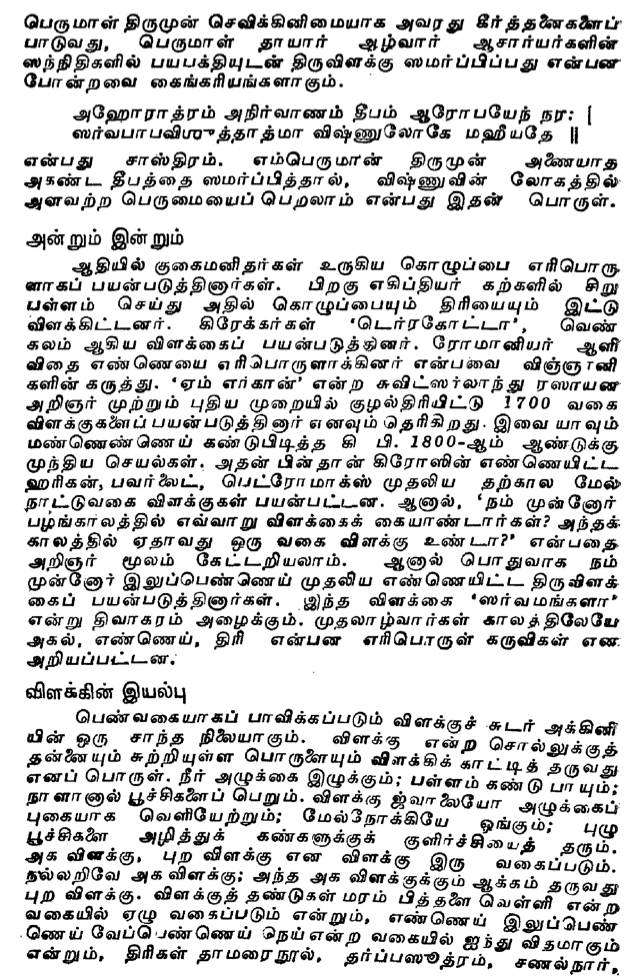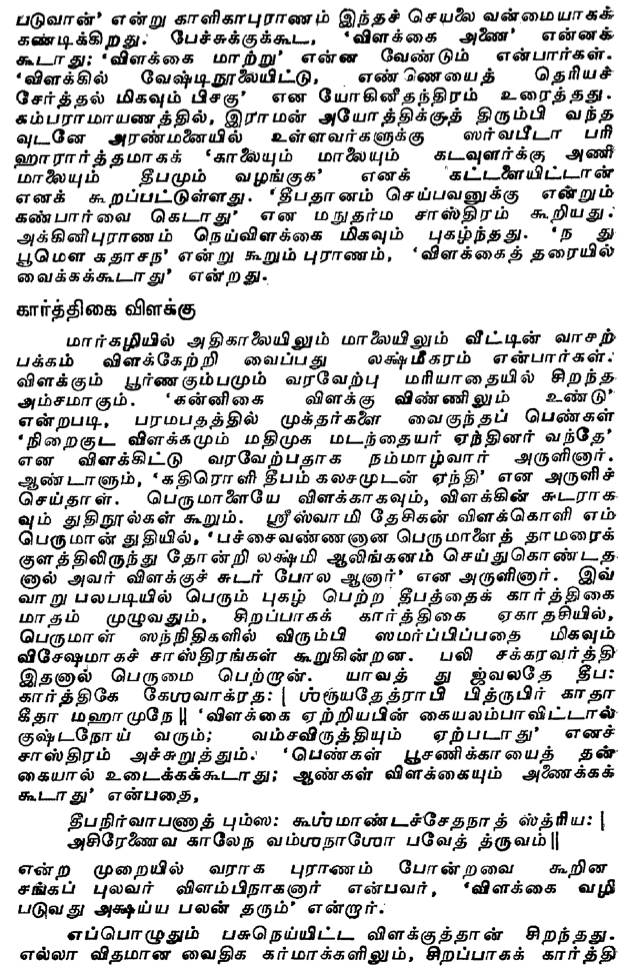As we all know, lighting lamp in front of the home deity is an integral part of our day to day activity. It is done early in the morning and again in the evening around sunset. It is one of the prime task attributed to the Stri of the respective house (Stri Dharma-
This article is in Tamil and if any of the reader of Anudinam is interested to translate this tamil article in English for the benefit of readers who cannot read Tamil, please mail us: srivaishnavanews@gmail.com, Thanks
Translation in English by Sri Kousik Sarathy:
The respected elders of our Sri Vaishnava Sampradaya, don’t always take to Perumal for petty issues and rather they took up whatever was part of life to be Perumal’s sankalpam. Their happiness lay in nothing but praising Perumal and singing mangalasasanams to Him. But those subservient elders have always humbly posited one wish to Perumal. That being they be given the opportunity to serve the Bhagavathas of Perumal, referred by the word “kuttreval”. Andal’s pasuram in Thiruppavai must be re-called here where she sang, “kuttreval engalai kollamal pogathu”. But this act of eternal servitude and service(kainkaryam) must not be equated with the worldly concept of slavery. The idea of servitude is capable of bringing all goodness and auspiciousness to one and all.
Such kainkaryams are explained in detail in the revered texts such as “Sri Pancharatram”. It says, the sanctum sanctorum of Perumal, that is at least 8×8 feet in dimension, should be firstly cleaned with cow dung and a kolam should be drawn using rice flour. This deepens Perumal’s grace on us and gives the women good health. The Perumal should then be decorated using the beautiful white flowers grown by the women themselves and knit together with a deep sense of Bhakti. When Perumal goes on a procession through the temple streets (thiruveedhi), one has to follow Him through the procession route. One should visit Perumal in the temple nearby, without petty talks one should conscientiously worship Him and afterwards go around(pradakshanam) the sanctum sanctorum, in soft steps and with the thought about Perumal in the mind. The number of pradakshanams should be even in number.
Some of the other kainkaryams include singing songs in praise of Perumal and lighting a lamp (vilakku) in the sacred place(sannidhi) of alzwars and acharyas. The quote from the above-said text means to say that lighting a lamp in Lord Vishnu’s sannidhi will lead to immense pleasure for us in His heavenly abode.
Practice – Then & now
Cavemen used molten fat to light lamps while the Egyptians used dented stone as a base and poured molten fat into it and used it. Greeks used “Terracotta” brass lamps as bases while Romans used seed oil to fuel lamps. There are also accounts of a Swiss chemist who used around 1700 types of wick-based lamps. All these accounts predate the discovery of kerosene which happened in 1800’s. It was only after this that the kerosene-lit western designed lamps types like hurricane lamps, petromax lamps starting catching up. But having accounted for all the western history, how did our ancestors light up their lamps? Were there any specific types of lamps then? The accounts state that Illupennai or Mahua (Botanical name: Bassia longifolia) was the oil of choice for our ancestors to light lamps. These lamps are called my the name “sarvamangala”. Even as early as the time of Mudal azhwars, instruments such as lamp(agal), wick(thiri) and oil were specifically known.
The lamp
An object that is associated with femininity, the flame from a lamp is considered to be a soft and stable form of fire(agni). The word vilakku (lamp) means the object that shows itself and the objects around it. While water agitates and takes the dirt with it, flows to the depths and is sometimes a breeding ground for insects. On the other hand, a lamp dissipates dirt as smoke upwards, always points and grows upwards, kills insects and keeps the eyes cool. The lamp mainly consists of two parts, the internal and the external part. Knowledge is the internal part and the part that identifies the internal is the external part of the lamp. The bark of a lamp can be made of seven materials such as brass, silver etc. The fuel might be any of the five varieties like iluppennai, ghee, neem oil etc. The wicks can be made of jute, lotus stem, dharbai sootram, plantation stem or cotton. Castor oil and cloth wicks are not to used in temples. Generally there a lot of types of lamps namely Agal vilakku, Ma vilakku, pavai vilakku, nunda vilakku, sara vilakku, chakra vilakku, mirror lamp, suzhal vilakku, kuthu vilakku, kumba veilakku and thorna vilakku.
Greatness of the lamp
‘Praying to the flame of a lamp in the dawn and the dusk shall bring one all punya’, says ‘Viradhasoodamani’. Also said is that viewing a ghee-lit lamp in the morning shall stabilize both the eyes and the thoughts. Moreover, it is good omen. Pagathebushanam, an old classic goes on to say that Godess Lakshmi’s permanent abode is in the lamp. Garuda Purana says that one should not lie down in the bed with a lamp to its west. Sadaprada stotram says that one should not enter an unlit temple. Jains extol the greatness of lamps with the name ‘balideepam’. Marwaris and Gujratis claim that a house which does have a lamp all day would fall into poverty. Kalikapuranam posts severe punishments to those who steal of blow off lamps lit for the Lord. Agni puranam while positing the greatness of a lamp says one should not place lamps on the ground.
Karthikai deepam
Placing a lit lamp in the dawn and dusk in front of the house in margazhi month is said to be auspicious. A lamp and a poorna kumbam hold a special place the welcoming rituals. The importance and the place given to a lamp is evident through various scriptures and from the sayings of azhwars and acharyas. The lamps have to be lit in the karthigai month and especially on Karthigai ekadasi day in Perumal’s sannidhi. Shastras threaten that one should wash hands well after the lighting of a lamp, else this will lead to leprosy and might lead to impotency. Varaha purana states that women are not to break pumpkins and men are not allowed to turn off the lamps. Vamana purana strongly advocates the deepa danam in the Karthigai ekadasi day. When a lamp is lit fueled by ghee and if the 5th rig of Sri Suktham is repeated 1000 times, one shall get what he had asked for, says the explanatory texts of Sri Suktham. Elders state that the Agni’s wife, Swahadevi’s form is nothing but the flame in the lamp. So, lighting of the lamp by women is considered important.
Such is the indescribable auspiciousness of a deepam that is presented here in a concise manner.















excellent explanation regarding lamp. pl continue your guidance in this regard.